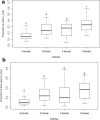Group size and aquatic vegetation modulates male preferences for female shoals in wild zebrafish, Danio rerio
- PMID: 33441931
- PMCID: PMC7807030
- DOI: 10.1038/s41598-020-80913-x
Group size and aquatic vegetation modulates male preferences for female shoals in wild zebrafish, Danio rerio
Abstract
Shoaling decisions in the wild are determined by a combination of innate preferences of the individual along with the interplay of multiple ecological factors. In their natural habitat as well as in the laboratory, zebrafish is a shoaling fish. Here, we investigate the role of group size and associated vegetation in shaping shoaling preferences of wild male zebrafish. We studied the association preference of males to groups of female shoals in a multi-choice test design. We found that males made greater proportion of visits to an 8-female group compared to 2 and 4-female groups. However, males spent similar proportions of time across the three female-containing groups. When artificial vegetation was incorporated along with female number as an additional factor, we found that males prefer high and moderately vegetated patches compared to low or no-vegetation groups, irrespective of the number of females in these patches. Based on experiments using a novel multi-choice design, our results show that preference for group size can change due to interaction of two separate factors. This work is a first attempt to understand the role of aquatic flora in determining shoaling preferences in zebrafish, using an experimental paradigm consisting of a gradation in female and vegetation densities.
Conflict of interest statement
The authors declare no competing interests.
Figures





References
Publication types
MeSH terms
LinkOut - more resources
Full Text Sources
Other Literature Sources

